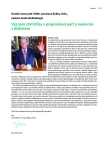Clinical and economic benefits of the new antidiabetic drugs in the Czech Republic
Authors:
Tomáš Doležal; Klára Kruntorádová
Authors‘ workplace:
Institut pro zdravotní ekonomiku a technology assessment (iHETA), Praha, ředitel MUDr. Tomáš Doležal, Ph. D.
Published in:
Vnitř Lék 2015; 61(Suppl 3): 50-53
Category:
Original Contributions
Overview
Goal:
Description of efficiency, safety and cost-effectiveness of the therapy with new antidiabetics from the incretins group for the patients whose treatment with DPP4 inhibitors and GLP1 receptor agonists respectively, commenced based on the real data from the routine clinical practice in the Czech Republic.
Methodology:
Collection of clinical data before the commencement of treatment and in the following 12 months. The following data was collected for all patients: demographic data, time elapsed from diagnosis, body weight, BMI, HbA1c, systolic and diastolic blood pressure, total cholesterol, LDL-cholesterol, HDL-cholesterol and triglycerides. After that a pharmacoeconomic model was analyzed which can predict long-term incidence of microvascular and macrovascular complications, life span and a quality-adjusted life-year (QALY) span of life.
Results:
The data of 320 patients followed for 12 months was analyzed (255 treated with DPP4 inhibitors and 65 treated with GLP1 receptor agonists). The patients‘ average age was 60.4/57.9 years and this innovative therapy was commenced for them after 9.1 years on average from their being diagnosed with diabetes. The initial glycated hemoglobin was higher (7.0%, or 7.6% HbA1c/IFCC). The previous therapy had been mainly based on metformin and on sulfonylurea derivatives. After 12 months of treatment statistically significant decreases were recorded in glycated hemoglobin (by 1.4% and 1.8% resp.), systolic blood pressure (by 4.7 mm Hg and 4.6 mm Hg resp.), diastolic blood pressure (by 1.8 mm Hg and 3.0 mm Hg resp.), LDL-cholesterol (by 0.3 mmol/l), triglycerides (by 0.4 mmol/l and 0.2 mmol/l resp.), body weight (by 1.6 kg and 4.5 kg resp.) and BMI (by 0.5 and 1.6 resp.). The pharmacoeconomic model predicted that the improvement of diabetes compensation in the group of DPP4 inhibitors would lead in one diabetic patient to life extension by 0.36 year and by 0.31 QALY, and in the group of GLP1 agonists by 0.45 year and by 0.39 QALY.
Conclusion:
The analysis has shown that the treatment based on modern antidiabetic medications in the conditions of the Czech Republic reduces the incidence of microvascular and macrovascular complications, extends the life span and the standard quality (QALY) life span and, due to the prevented complications, also reduces health insurance spending.
Key words:
GLP1 receptor agonists – diabetes mellitus – pharmacoeconomics – DPP4 inhibitors – QALY
Sources
1. Doležal T, Písaříková Z, Zemanová P et al. Náklady na diabetes 2. typu v podmínkách zdravotního systému České republiky. Vnitř Lék 2009; 55(4): 342–344.
2. Kvapil M. Distribuce hodnot glykovaného hemoglobinu v populaci diabetiků 2. typu: projekt Valetudo. Vnitř Lék 2015; 61(1): 81–83.
3. Zhong Y, Lin PJ, Cohen JT et al. Cost-utility analyses in diabetes: a systematic review and implications from real-world evidence. Value Health 2015; 18(2): 308–314.
4. Wouters OJ, Naci H, Samani NJ QALYs in cost-effectiveness analysis: an overview for cardiologists. Heart 2015; pii: heartjnl-2015–308255. Dostupné z DOI: <http://doi: 10.1136/heartjnl-2015–308255>.
5. Bartášková D, Kožnarová R, Kvapil M. Analýza farmakoekonomických aspektů léčby diabetes mellitus v České republice. Remedia 2004; 14(4) 377–384.
6. Clarke PM et al. A model to estimate the lifetime health outcomes of patients with Type 2 diabetes: the United Kingdom Prospective Diabetes Study (UKPDS) Outcomes Model (UKPDS no. 68). Diabetologia 2004; 47(10): 1747–1759.
Labels
Diabetology Endocrinology Internal medicineArticle was published in
Internal Medicine

2015 Issue Suppl 3
Most read in this issue
- Incidence of amputations among patients with diabetes mellitus in the Czech Republic from 2010 to 2014
- The mortality of patients with diabetes mellitus using oral antidiabetic drugs in the Czech Republic decreased over the decade of 2003–2013 and came closer to the population average
- Monitoring of diabetes compensation in patients treated with an insulin pump in the Czech Republic
- Clinical and economic benefits of the new antidiabetic drugs in the Czech Republic
